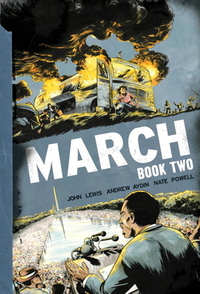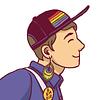You need to sign in or sign up before continuing.
Take a photo of a barcode or cover
This is the second book in the March graphic novel trilogy that is told by Congressman John Lewis, one of the key figures of the civil rights movement. In this graphic novel trilogy John Lewis tells his story about his participation in the civil rights movement. In this book he talks about the protests that he and his fellow Freedom Riders participated in. These graphic novel books are amazing. I love the art and the way the story is told. John Lewis is an amazing, iconic figure and I'm happy that I reading his story about what he and many others faced to get to where we are today. This is a very eyeopening book and the art makes it even better because we get to see the story unfold in a unique way. I would highly recommend reading this book because it's powerful and it's a book that I think everyone should read. I'm very excited to pick up the third book in this trilogy!
Even better than the first. So many interesting details brought to life in this graphic novel. Learned a lot about the Freedom Riders I never knew and learned lots of new facts about the March on Washington, probably the moment in the Civil Rights Movement I learned the most about in school.
For example, I had never heard of Baynard Rustin who was the deputy of the event and ran a lot of the logistics. He was gay and through FBI wiretapping efforts, a South Carolinian congressman tried to silence him and the March of Washington by outing him publicly. Baynard persisted.
For example, I had never heard of Baynard Rustin who was the deputy of the event and ran a lot of the logistics. He was gay and through FBI wiretapping efforts, a South Carolinian congressman tried to silence him and the March of Washington by outing him publicly. Baynard persisted.
emotional
hopeful
informative
inspiring
fast-paced
For all the talk of the Civil Rights Movement in schools, it's rare to hear more than Martin Luther King Jr, Ruby Bridges, and Rosa Parks. But March shows us now of what was happening: John Lewis, the Freedom Riders, the strategic meetings over protest locations and goals.
This trilogy needs to be required reading in schools, especially as we face more open racism in our current political climate.
This trilogy needs to be required reading in schools, especially as we face more open racism in our current political climate.
This is a captivating way to tell John Lewis's story as a Freedom Rider. It really puts you into the action, explaining many of the details about these events to help you to better understand what was at stake and what protesters actually risked. Powell's images are both beautiful and haunting. I want to include this book in my classes and I can't wait for book three.
This is the second book in the graphic novel biography of Congressman John Lewis (Ga-5), and it is even more gripping than the first volume. The story cuts back and forth between brief scenes of President Obama's swearing in as the President of the United States and Lewis's experiences as the leader of the SNCC (the Student Non-Violent Coordinating Committee) in the early 1960s. Lewis participated in the Freedom Ride to test the desegregation of the bus system that lead to devastating violence in Birmingham, Alabama. The contrast of seeing Lewis being beaten and jailed in the South, then invited to meetings at the White House and personally acknowledged by Robert Kennedy, is astonishing. Lewis was one of the six speakers on the Washington DC March on August 28th, 1963, and his speech to this day is moving and necessary. Nate Powell's expressive, detailed and historically accurate drawings keep this book humming with energy.
Like, what am I even doing with my life? Also, changing my perception of MLK Jr. Did not see that coming....part 2
This book was much more emotional and powerful than book one, and I think the authors are doing a great job of building to a spectacular finish in book three. I don't know what I was expecting, but I don't think I expected this book, which is easily double the size of the first installment, to include so much of the Civil Rights Movement, and so many people who were involved.
I did have some complaints with the graphic novel's format. Some of the jumps between topics were hard to follow at first, but not enough to detract from the overall story. Additionally, like the first book, some of the writing was small. I also came away wondering why he included certain lines. Lewis makes it clear that he did not agree with Malcolm X much of the time, but he had great respect for him. He also includes incidents where Dr. King or James Farmer's opinions or actions don't coincide with his or SNCC's. I didn't feel like he gave the same respect to Stokely Carmichael, however. Obviously the two took SNCC in different directions, but while he showed reverence to others he disagreed with, he seemed to dig at Carmichael. I wondered if that was his intention, or just my reading too much into the situation.
Regardless of any misgivings I had, I thought that this graphic novel was an engaging and informative retelling of John Lewis's personal story, and with that, gave an in-depth look into the broader Civil Rights struggle. This will be fantastic in the classroom, but I would recommend to people of all ages as well.
I did have some complaints with the graphic novel's format. Some of the jumps between topics were hard to follow at first, but not enough to detract from the overall story. Additionally, like the first book, some of the writing was small. I also came away wondering why he included certain lines. Lewis makes it clear that he did not agree with Malcolm X much of the time, but he had great respect for him. He also includes incidents where Dr. King or James Farmer's opinions or actions don't coincide with his or SNCC's. I didn't feel like he gave the same respect to Stokely Carmichael, however. Obviously the two took SNCC in different directions, but while he showed reverence to others he disagreed with, he seemed to dig at Carmichael. I wondered if that was his intention, or just my reading too much into the situation.
Regardless of any misgivings I had, I thought that this graphic novel was an engaging and informative retelling of John Lewis's personal story, and with that, gave an in-depth look into the broader Civil Rights struggle. This will be fantastic in the classroom, but I would recommend to people of all ages as well.
Another gripping, horrifying, important installment of March by John Lewis. The first book had some tender moments, in Lewis' childhood, but in book two, we are fully in the swing of his work with the Civil Rights Movement, the various sit-ins and marches and meetings. You begin to see the true horror of white responses to the protests, the water hoses and dogs, spitting and beating and killing. It's truly horrifying, especially when it's turned on children and pregnant women and even lawyers/ government representatives. No one was safe from the violence of virulent racism.
I guess technically I knew much of this already, but the graphic format and the personal recounting of the events make the facts so much more vivid and shocking and visceral. Especially now, in a country that needs Black Lives Matters to keep black bodies safe from police and vigilante violence. The more things change, the more they stay the same.
I found the little glimpses of other famous African-American leaders to be fascinating and tantalizing, especially the glimpses of Malcolm X, and Lewis' brief comments on Malcolm's approach to civil rights.
My only possible critique is that the artwork could be a little confusing and/or ambiguous sometimes....did that truck hit the little girl, or did it speed past her? Was the protester dead, or just severely beaten? There's definitely a sense of action. I just had trouble following it sometimes.
The work that Representative Lewis and the others with him, not on the the rest of the Big Six, but also all the less famous bodies with and behind them, is incredibly important, and this series is an incredibly important addition to the canon of black historical writing. Instead of dry history texts, I think books like this series would be much more effective ways of teaching history in schools. And they certainly stand on their own merit as gripping, vital stories that deserve to be read.
I guess technically I knew much of this already, but the graphic format and the personal recounting of the events make the facts so much more vivid and shocking and visceral. Especially now, in a country that needs Black Lives Matters to keep black bodies safe from police and vigilante violence. The more things change, the more they stay the same.
I found the little glimpses of other famous African-American leaders to be fascinating and tantalizing, especially the glimpses of Malcolm X, and Lewis' brief comments on Malcolm's approach to civil rights.
My only possible critique is that the artwork could be a little confusing and/or ambiguous sometimes....did that truck hit the little girl, or did it speed past her? Was the protester dead, or just severely beaten? There's definitely a sense of action. I just had trouble following it sometimes.
The work that Representative Lewis and the others with him, not on the the rest of the Big Six, but also all the less famous bodies with and behind them, is incredibly important, and this series is an incredibly important addition to the canon of black historical writing. Instead of dry history texts, I think books like this series would be much more effective ways of teaching history in schools. And they certainly stand on their own merit as gripping, vital stories that deserve to be read.
It was hard to read the horrifying true accounts in this book but important for me to be more aware of them. I read this series in one day and found it informative and compelling.





